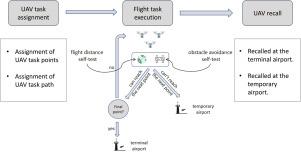Distributed decision making for unmanned aerial vehicle inspection with limited energy constraint
IF 9.6
Q1 COMPUTER SCIENCE, ARTIFICIAL INTELLIGENCE
引用次数: 0
Abstract
The unsatisfactory energy density of the state-of-art batteries imposes constraints on the practical application of unmanned aerial vehicles (UAVs). Establishing a UAV airport network that integrates energy supply and information exchange functionalities represents an ideal solution for enabling synergistic UAV operations. However, devising efficient distribution protocols for these airports remains a challenge. By leveraging modeling and analysis of the energy density of existing UAV batteries, we can forecast the flight range and distances achievable by UAVs. Here, we propose a distribution protocol for UAV airport platforms aimed at enhancing distribution accuracy by the use of AI principles. Furthermore, considering the possibility of emergency UAV stop, we introduce an emergency stop system in conjunction with standard stopping procedures to optimize distribution efficiency and enhance UAV inspection safety. Moreover, existing UAV airports usually provide energy to UAVs without harnessing UAVs to facilitate interconnection and interoperability among different airports. This inefficiency leads to significant resource wastage in energy distribution. To address this, we introduce a shared energy network that allows different companies to operate according to energy distribution needs. This network not only supplies energy to UAVs but also employs UAVs for energy collection and transportation, facilitating energy trading, business collaboration, and data transmission among diverse organizations. By enabling ubiquitous energy trading, this study provides us an ideal strategy for the future construction of energy network with interconnection and interoperability, which can be extended to other applications calling for energy distribution.

能源有限的无人飞行器巡检分布式决策
最先进电池的能量密度不尽人意,制约了无人驾驶飞行器(UAV)的实际应用。建立集能源供应和信息交换功能于一体的无人机机场网络是实现无人机协同运行的理想解决方案。然而,为这些机场设计高效的分配协议仍然是一项挑战。通过对现有无人机电池能量密度的建模和分析,我们可以预测无人机的飞行范围和可达到的距离。在此,我们提出了一种无人机机场平台分配协议,旨在利用人工智能原理提高分配精度。此外,考虑到无人机紧急停机的可能性,我们结合标准停机程序引入了紧急停机系统,以优化分配效率并提高无人机巡查安全性。此外,现有的无人机机场通常为无人机提供能源,而没有利用无人机促进不同机场之间的互联互通。这种低效率导致能源分配中的大量资源浪费。为解决这一问题,我们引入了一个共享能源网络,允许不同公司根据能源分配需求进行运营。该网络不仅为无人机提供能源,还利用无人机收集和运输能源,促进不同组织之间的能源交易、业务协作和数据传输。通过实现无处不在的能源交易,这项研究为我们提供了一种理想的策略,有助于未来构建具有互联互通功能的能源网络,并可将其扩展到其他需要能源分配的应用领域。
本文章由计算机程序翻译,如有差异,请以英文原文为准。
求助全文
约1分钟内获得全文
求助全文
来源期刊

Energy and AI
Engineering-Engineering (miscellaneous)
CiteScore
16.50
自引率
0.00%
发文量
64
审稿时长
56 days
 求助内容:
求助内容: 应助结果提醒方式:
应助结果提醒方式:


